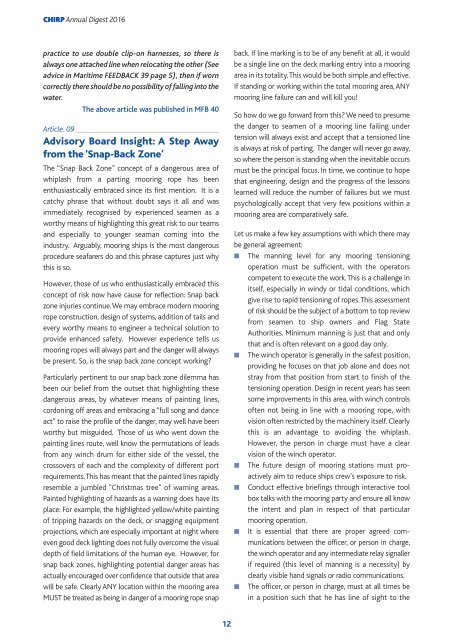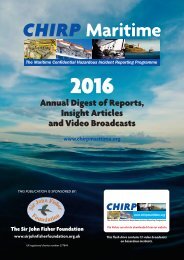CHIRP annual digest 2016 6th
Create successful ePaper yourself
Turn your PDF publications into a flip-book with our unique Google optimized e-Paper software.
<strong>CHIRP</strong> Annual Digest <strong>2016</strong><br />
practice to use double clip-on harnesses, so there is<br />
always one attached line when relocating the other (See<br />
advice in Maritime FEEDBACK 39 page 5), then if worn<br />
correctly there should be no possibility of falling into the<br />
water.<br />
The above article was published in MFB 40<br />
Article. 09<br />
Advisory Board Insight: A Step Away<br />
from the ‘Snap-Back Zone’<br />
The “Snap Back Zone” concept of a dangerous area of<br />
whiplash from a parting mooring rope has been<br />
enthusiastically embraced since its first mention. It is a<br />
catchy phrase that without doubt says it all and was<br />
immediately recognised by experienced seamen as a<br />
worthy means of highlighting this great risk to our teams<br />
and especially to younger seaman coming into the<br />
industry. Arguably, mooring ships is the most dangerous<br />
procedure seafarers do and this phrase captures just why<br />
this is so.<br />
However, those of us who enthusiastically embraced this<br />
concept of risk now have cause for reflection: Snap back<br />
zone injuries continue. We may embrace modern mooring<br />
rope construction, design of systems, addition of tails and<br />
every worthy means to engineer a technical solution to<br />
provide enhanced safety. However experience tells us<br />
mooring ropes will always part and the danger will always<br />
be present. So, is the snap back zone concept working?<br />
Particularly pertinent to our snap back zone dilemma has<br />
been our belief from the outset that highlighting these<br />
dangerous areas, by whatever means of painting lines,<br />
cordoning off areas and embracing a “full song and dance<br />
act” to raise the profile of the danger, may well have been<br />
worthy but misguided. Those of us who went down the<br />
painting lines route, well know the permutations of leads<br />
from any winch drum for either side of the vessel, the<br />
crossovers of each and the complexity of different port<br />
requirements. This has meant that the painted lines rapidly<br />
resemble a jumbled “Christmas tree” of warning areas.<br />
Painted highlighting of hazards as a warning does have its<br />
place: For example, the highlighted yellow/white painting<br />
of tripping hazards on the deck, or snagging equipment<br />
projections, which are especially important at night where<br />
even good deck lighting does not fully overcome the visual<br />
depth of field limitations of the human eye. However, for<br />
snap back zones, highlighting potential danger areas has<br />
actually encouraged over confidence that outside that area<br />
will be safe. Clearly ANY location within the mooring area<br />
MUST be treated as being in danger of a mooring rope snap<br />
back. If line marking is to be of any benefit at all, it would<br />
be a single line on the deck marking entry into a mooring<br />
area in its totality. This would be both simple and effective.<br />
If standing or working within the total mooring area, ANY<br />
mooring line failure can and will kill you!<br />
So how do we go forward from this? We need to presume<br />
the danger to seamen of a mooring line failing under<br />
tension will always exist and accept that a tensioned line<br />
is always at risk of parting. The danger will never go away,<br />
so where the person is standing when the inevitable occurs<br />
must be the principal focus. In time, we continue to hope<br />
that engineering, design and the progress of the lessons<br />
learned will reduce the number of failures but we must<br />
psychologically accept that very few positions within a<br />
mooring area are comparatively safe.<br />
Let us make a few key assumptions with which there may<br />
be general agreement:<br />
■ The manning level for any mooring tensioning<br />
operation must be sufficient, with the operators<br />
competent to execute the work. This is a challenge in<br />
itself, especially in windy or tidal conditions, which<br />
give rise to rapid tensioning of ropes. This assessment<br />
of risk should be the subject of a bottom to top review<br />
from seamen to ship owners and Flag State<br />
Authorities. Minimum manning is just that and only<br />
that and is often relevant on a good day only.<br />
■ The winch operator is generally in the safest position,<br />
providing he focuses on that job alone and does not<br />
stray from that position from start to finish of the<br />
tensioning operation. Design in recent years has seen<br />
some improvements in this area, with winch controls<br />
often not being in line with a mooring rope, with<br />
vision often restricted by the machinery itself. Clearly<br />
this is an advantage to avoiding the whiplash.<br />
However, the person in charge must have a clear<br />
vision of the winch operator.<br />
■ The future design of mooring stations must pro -<br />
actively aim to reduce ships crew’s exposure to risk.<br />
■ Conduct effective briefings through interactive tool<br />
box talks with the mooring party and ensure all know<br />
the intent and plan in respect of that particular<br />
mooring operation.<br />
■ It is essential that there are proper agreed com -<br />
munications between the officer, or person in charge,<br />
the winch operator and any intermediate relay signaller<br />
if required (this level of manning is a necessity) by<br />
clearly visible hand signals or radio communications.<br />
■ The officer, or person in charge, must at all times be<br />
in a position such that he has line of sight to the<br />
12



